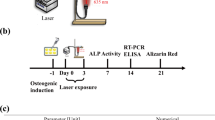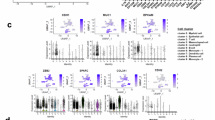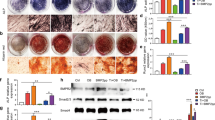Abstract
Parietal foramina [PFM], inherited usually in an autosomal dominant mode, is an extremely rare developmental defect characterized by a symmetrical, oval hole in the parietal bone. It can be present as either an isolated or a syndromic feature. PFM types 1 and 2 (PFM1 and PFM2) have been found to be caused by mutations in the MSX2 and ALX4 genes, located to chromosomes 5 and 11, respectively. After exclusion of both the above loci in a large Chinese pedigree with autosomal dominant PFM, a genome-wide search revealed a linkage of the PFM to markers at the 4q21-q23 region. The maximum LOD score from two-point linkage analysis is 3.87 for marker D4S2961. Analysis of co-segregated haplotype localized the region to a 20-cM interval that flanks D4S392 and D4S2945. Therefore, we concluded that the PFM in the family is a new PFM locus. Although three genes, BMPR1B, PP1 and IBSP, are located to 4q21-q25 and their functions are related to bone morphogenesis, no mutations were identified by sequencing analysis of their exons.
Similar content being viewed by others
Log in or create a free account to read this content
Gain free access to this article, as well as selected content from this journal and more on nature.com
or
References
Astrom AK, Jin D, Imamura T, Roijer E, Rosenzweig B, Miyazono K, ten Dijke P, Stenman G (1999) Chromosomal localization of three human genes encoding bone morphogenetic protein receptors. Mamm Genome 10:299–302
Bartsch O, Wuyts W, Van Hul W, Hecht JT, Meinecke P, Hogue D, Werner W, Zabel B, Hinkel GK, Powell CM, Shaffer LG, Willems PJ (1996) Delineation of a contiguous gene syndrome with multiple exostoses, enlarged parietal foramina, craniofacial dysostosis, and mental retardation, caused by deletions in the short arm of chromosome 11. Am J Hum Genet 58:734–742
Boras K, Hamel PA (2002) Alx4 binding to LEF-1 regulates N-CAM promoter activity. J Biol Chem 277:1120–1127
Cohen MM (2000) Craniofacial disorders caused by mutations in homeobox genes MSX1 and MSX2. J Craniofac Genet Dev Biol 20:19–25
Curtis D, Gurling H (1993) A procedure for combining two-point lod scores into a summary multipoint map. Hum Hered 43:173-185
Damji KF, Gallione CJ, Allingham RR, Slotterbeck B, Guttmacher AE, Pasyk KA, Vance JM, Pericak-Vance MA, Speer MC, Marchuk DA (1998) Quantitative DNA pooling to increase the efficiency of linkage analysis in autosomal dominant disease. Hum Genet 102:207–212
Dib C, Faure S, Fizames C, Samson D, Drouot N, Vignal A, Millasseau P, Marc S, Hazan J, Seboun E, Lathrop M, Gyapay G, Morissette J, Weissenbach J (1996) A comprehensive genetic map of the human genome based on 5,264 microsatellites. Nature 380:152–154
Fein JM, Brinker RA (1972) Evolution and significance of giant parietal foramina. Report of five cases in one family. J Neurosurg 37:487–492
Fisher LW, McBride OW, Termine JD, Young MF (1990) Human bone sialoprotein. Deduced protein sequence and chromosomal localization. J Biol Chem 265:2347-2351
Golabi M, Carey J, Hall BD (1984) Parietal foramina clavicular hypoplasia. An autosomal dominant syndrome. Am J Dis Child 138:596–599
Kruglyak L, Lander ES (1998) Faster Multipoint Linkage Analysis Using Fourier Transforms. J Comput Biol 5:1–7
Lathrop GM, Lalouel JM, Julier C, Ott J (1985) Multilocus linkage analysis in humans: detection of linkage and estimation of recombination. Am J Hum Genet 37:482–498
Little BB, Knoll KA, Klein VR, Heller KB (1990) Hereditary cranium bifidum and symmetric parietal foramina are the same entity. Am J Med Genet 35:453–458
Liu W, Wang H, Zhao S, Zhao W, Bai S, Zhao Y, Xu S, Wu C, Huang W, Chen Z, Feng G, He L (2001) The novel gene locus for agenesis of permanent teeth (He-Zhao deficiency) maps to chromosome 10q11.2. J Dent Res 80:1716-1720
Mavrogiannis LA, Antonopoulou I, Baxova A, Kutilek S, Kim CA, Sugayama SM, Salamanca A, Wall SA, Morriss-Kay GM, Wilkie AO (2001) Haploinsufficiency of the human homeobox gene ALX4 causes skull ossification defects. Nat Genet 27:17–18
Okuda O, Ikutomi H (1965) Two cases of foramina parietalia permagna occurring in the same family. No To Shinkei 17:1255–1259
Pang D, Lin A (1982) Symptomatic large parietal foramina. Neurosurgery 11:33–37
Potocki L, Shaffer LG (1996) Interstitial deletion of 11 (p11.2p12): A newly described contiguous gene deletion syndrome involving the gene for hereditary multiple exostoses (EXT2). Am J Med Genet 62:319–325
Reinholt FP, Hultenby K, Oldberg A, Heinegard D (1990) Osteopontin — a possible anchor of osteoclasts to bone. Proc Nat Acad Sci USA 87:4473–4475
Satokata I, Ma L, Ohshima H, Bei M, Woo I, Nishizawa K, Maeda T, Takano Y, Uchiyama M, Heaney S, Peters H, Tang Z, Maxson R, Maas R (2000) MSX2 deficiency in mice causes pleiotropic defects in bone growth and ectodermal organ formation. Nat Genet 24: 391–395
Shaffer LG, Hecht JT, Ledbetter DH, Greenberg F (1993) Familial interstitial deletion 11(p11.12p12) associated with parietal foramina, brachymicrocephaly, and mental retardation. Am J Med Genet 45:581–583
Wilkie AO, Tang Z, Elanko N, Walsh S, Twigg SR, Hurst JA, Wall SA, Chrzanowska KH, Maxson RE (2000) Functional haploinsufficiency of the human homeobox gene MSX2 causes defects in skull ossification. Nat Genet 24:387–390
Wu YQ, Badano JL, McCaskill C, Vogel H, Potocki L, Shaffer LG (2000) Haploinsufficiency of ALX4 as a potential cause of parietal foramina in the 11p11.2 contiguous gene-deletion syndrome. Am J Hum Genet 67:1327–1332
Wuyts W, Cleiren E, Homfray T, Rasore QA, Vanhoenacker F, Van HW (2000a) The ALX4 homeobox gene is mutated in patients with ossification defects of the skull. J Med Genet 37:916–920
Wuyts W, Reardon W, Preis S, Homfray T, Rasore-Quartino A, Christians H, Willems PJ, Van HW (2000b) Identification of mutations in the MSX2 homeobox gene in families affected with foramina parietalia permagna. Hum Mol Genet 9:1251–1255
Yang X, She C, Guo J, Yu AC, Lu Y, Shi X, Feng G, He L (2000) A locus for brachydactyly type A-1 maps to chromosome 2q35-q36. Am J Hum Genet 66:892–903
Young ID, Swift PG (1985) Parietal foramina in the Saethre-Chotzen syndrome. J Med Genet 22:413–414
Zabek M (1987) Familial incidence of foramina parietalia permagna. Neurochirurgia 30:25–27
Acknowledgements
We would like to thank the National 973 and 863 Projects, the Shanghai Municipal Commission of Science and Technology, and the National Natural Science Foundation of China for generous financial support. We are also grateful to all of individuals of this family for their participation and to Dr. Wim Wuyts for providing valuable information concerning his research.
Author information
Authors and Affiliations
Corresponding author
Rights and permissions
About this article
Cite this article
Chen, G., Zhang, D., Feng, G. et al. A novel locus for parietal foramina maps to chromosome 4q21-q23. J Hum Genet 48, 420–424 (2003). https://doi.org/10.1007/s10038-003-0050-2
Received:
Accepted:
Published:
Issue date:
DOI: https://doi.org/10.1007/s10038-003-0050-2
Keywords
This article is cited by
-
Enlarged parietal foramina: a rare forensic autopsy finding
International Journal of Legal Medicine (2016)
-
Enlarged parietal foramina: a review of genetics, prognosis, radiology, and treatment
Child's Nervous System (2013)
-
Enlarged parietal foramina caused by mutations in the homeobox genes ALX4 and MSX2: from genotype to phenotype
European Journal of Human Genetics (2006)



